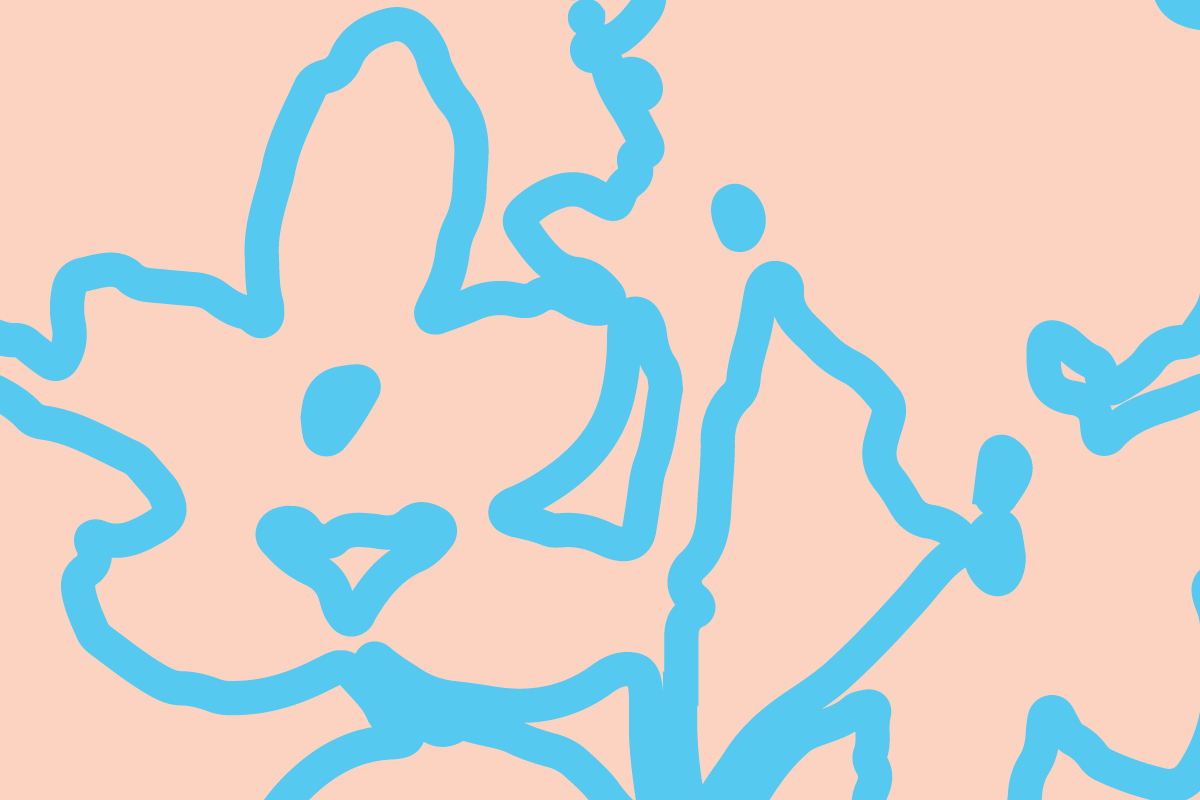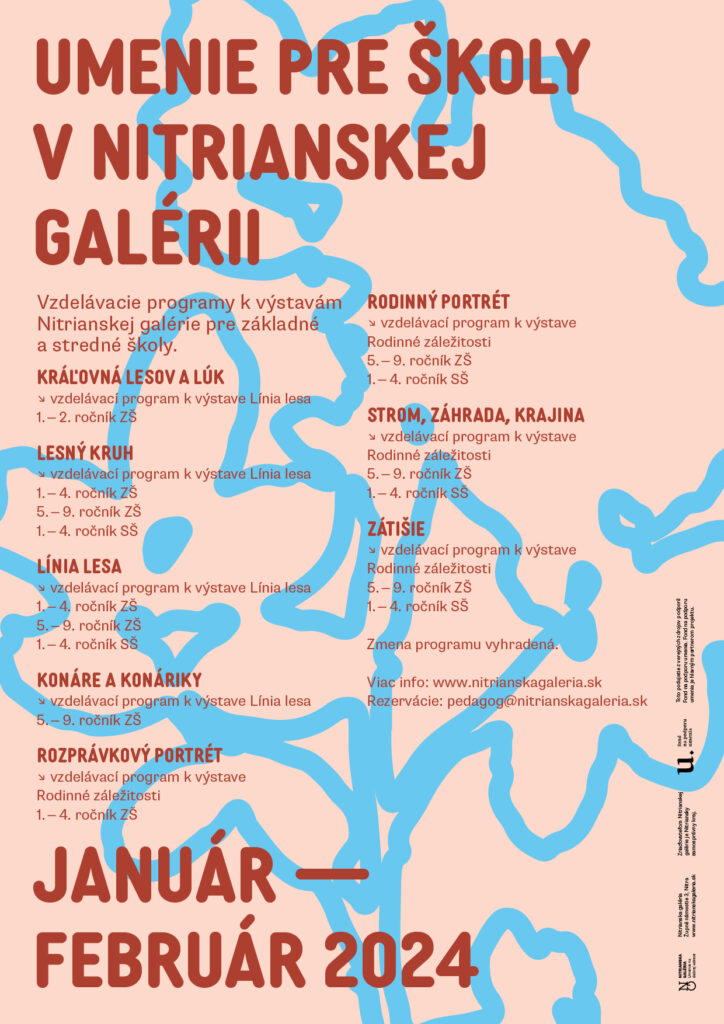Information
Art Teachers
Martin Daniš
Elena Tarábková
Admission
Supervising Teachers, Students of Primary and Secondary Schools: Free
(a lecturer-commented tour of the exhibition and art supplies are included in the price)
Maximum number of participants: 25
Duration
60 min.
Venue
exhibition spaces, art studio
Time
Tuesday–Friday, 10.15am – 5.30pm
Reservations
pedagog@nitrianskagaleria.sk
phone: 037 657 96 41
Support
With financial support of the Slovak Arts Council public funds. The Council is the leading partner of the project.
Educational programs for the Forest Line exhibition
Queen of Forests and Meadows
The educational program will teach us what belongs to the forest and what does not. Why certain plant species have disappeared from our region and others have had to adapt or move. Whether these plants are able to withstand their new conditions. The main creative activity focuses on creating headgear (a crown, wreath, veil, …) from materials found in forests (natural materials: branches, leaves, needles, cones and unnatural materials: plastics, bottle caps, etc.). At the end, the students will be crowned kings and queens of forests and meadows. Their new roles will include an obligation to plant a new forest – by planting seeds in the ground.
Primary School Grades 1–2
Forest Circle
The main creative activity will focus on creating a circular composition directly in the exhibition space using natural materials, small objects and paper adhesive tape (branches, leaves, needles, cones, feathers, egg shells, stones, plastics, bottle caps, nets, adhesive tape, etc.). The students will create temporary mandalas on the floor, either individually or in groups, and take a record of them in the form of photographs. At the end, all the mandalas will be merged together in order to create a symbolical connection between nature, the exhibition and its visitors.
Primary School Grades 1–4
Forest Line
We will try and reimagine one of our trips to nature. Surrounded by pieces of art, we will “teleport” ourselves into nature and try to recall the sounds of a flowing stream, falling leaves, rain, snow, wind, … As a part of the creative activity, we will try to come up with a visual form of the selected place while incorporating natural materials like mud, leaves and needles. During the guided tour of the Forest Line exhibition, we will learn why some artists choose to use materials from nature.
Primary School Grades 1–4
Educational programs for the Family Matters exhibition
Fairytale Portrait
An alternative to the “Family Portrait” educational program aimed at primary schools, grades 1–4. We will be transferred to a fairytale where we will help the Prince and Princess fulfil various tasks hidden in a box.
Primary School Grades 1–4
Programming is subject to change.
Educational programs for the Forest Line exhibition
Forest Circle
The main creative activity will focus on creating a circular composition directly in the exhibition space using natural materials, small objects and paper adhesive tape (branches, leaves, needles, cones, feathers, egg shells, stones, plastics, bottle caps, nets, adhesive tape, etc.). The students will create temporary mandalas on the floor, either individually or in groups, and take a record of them in the form of photographs. At the end, all the mandalas will be merged together in order to create a symbolical connection between nature, the exhibition and its visitors.
Primary School Grades 5–9
Forest Line
We will try and reimagine one of our trips to nature. Surrounded by pieces of art, we will “teleport” ourselves into nature and try to recall the sounds of a flowing stream, falling leaves, rain, snow, wind, … As a part of the creative activity, we will try to come up with a visual form of the selected place while incorporating natural materials like mud, leaves and needles. During the guided tour of the Forest Line exhibition, we will learn why some artists choose to use materials from nature.
Primary School Grades 5–9
Bigger and Smaller Branches
The main creative activity will focus on creating objects made of natural materials (branches, leaves, needles, etc.). The students will glue leaves and needles to branches, thus creating new species of trees and different objects.
Primary School Grades 5–9
Educational programs for the Family Matters exhibition
Family Portrait
A young woman’s portrait captures her dressed in period clothes with a bouquet of roses. She is depicted in a semi-profile with a dreamy expression on her face, staring beyond the picture frame. The image by the painter Raimund von Wichera became a part of the Nitra Gallery collection when it was donated by the artist’s niece Malvína Wicherová who had inherited the images from Wichera’s siblings.
In the past (before the invention of photography), portraits used to be very important. Not everybody could afford them, which is why mostly town houses and noble houses had images of ancestors hanging on their walls, so they would not get forgotten. What kind of images are on the walls of your homes? Do you have any drawn or painted portraits of your relatives? We will draw inspiration from the Family Matters exhibition and create a portrait of a relative we like to think about the most.
Primary School Grades 5–9
Tree, Garden, Landscape
Every season has its own specific features. Let’s try and assign them colours. Which are the colours of autumn, winter, spring or summer? How does a tree or garden change over the course of a year? Can we identify the seasons depicted in the images by Maximilián Schurmann, Jozef Srna Sr and Ján Mudroch? We will pick a tree from the gallery courtyard and record how it changes over the course of days, weeks and months by drawing, painting or photographing the process. Each group will showcase the changes captured across different hours, days, seasons, weather conditions. Together, we will create a single tree’s diary.
Primary School Grades 5–9
Still Life
What kind of objects depicted still lifes of the past? What would today’s still lifes look like? As a part of this program, we will try and create a still life that expresses ourselves.
Primary School Grades 5–9
Programming is subject to change.
Educational programs for the Forest Line exhibition
Forest Circle
The main creative activity will focus on creating a circular composition directly in the exhibition space using natural materials, small objects and paper adhesive tape (branches, leaves, needles, cones, feathers, egg shells, stones, plastics, bottle caps, nets, adhesive tape, etc.). The students will create temporary mandalas on the floor, either individually or in groups, and take a record of them in the form of photographs. At the end, all the mandalas will be merged together in order to create a symbolical connection between nature, the exhibition and its visitors.
Secondary School Grades 1–4
Grammar School Grades 1–8
Forest Line
We will try and reimagine one of our trips to nature. Surrounded by pieces of art, we will “teleport” ourselves into nature and try to recall the sounds of a flowing stream, falling leaves, rain, snow, wind, … As a part of the creative activity, we will try to come up with a visual form of the selected place while incorporating natural materials like mud, leaves and needles. During the guided tour of the Forest Line exhibition, we will learn why some artists choose to use materials from nature.
Secondary School Grades 1–4
Grammar School Grades 1–8
Bigger and Smaller Branches
The main creative activity will focus on creating objects made of natural materials (branches, leaves, needles, etc.). The students will glue leaves and needles to branches, thus creating new species of trees and different objects.
Secondary School Grades 1–4
Grammar School Grades 1–8
Educational programs for the Family Matters exhibition
Family Portrait
A young woman’s portrait captures her dressed in period clothes with a bouquet of roses. She is depicted in a semi-profile with a dreamy expression on her face, staring beyond the picture frame. The image by the painter Raimund von Wichera became a part of the Nitra Gallery collection when it was donated by the artist’s niece Malvína Wicherová who had inherited the images from Wichera’s siblings.
In the past (before the invention of photography), portraits used to be very important. Not everybody could afford them, which is why mostly town houses and noble houses had images of ancestors hanging on their walls, so they would not get forgotten. What kind of images are on the walls of your homes? Do you have any drawn or painted portraits of your relatives? We will draw inspiration from the Family Matters exhibition and create a portrait of a relative we like to think about the most.
Secondary School Grades 1–4
Grammar School Grades 1–8
Tree, Garden, Landscape
Every season has its own specific features. Let’s try and assign them colours. Which are the colours of autumn, winter, spring or summer? How does a tree or garden change over the course of a year? Can we identify the seasons depicted in the images by Maximilián Schurmann, Jozef Srna Sr and Ján Mudroch? We will pick a tree from the gallery courtyard and record how it changes over the course of days, weeks and months by drawing, painting or photographing the process. Each group will showcase the changes captured across different hours, days, seasons, weather conditions. Together, we will create a single tree’s diary.
Secondary School Grades 1–4
Grammar School Grades 1–8
Still Life
What kind of objects depicted still lifes of the past? What would today’s still lifes look like? As a part of this program, we will try and create a still life that expresses ourselves.
Secondary School Grades 1–4
Grammar School Grades 1–8
Programming is subject to change.

